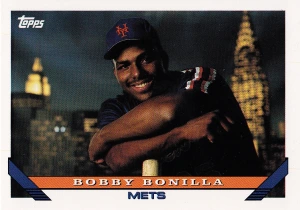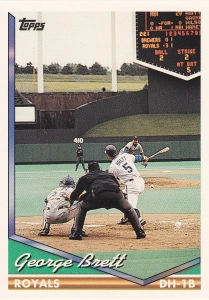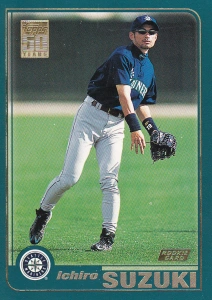An overview of the 1984 Topps set:
- 792 cards in the set – the same since 1982.
- Subsets: 1983 Highlights (1-6), League Leaders (131-138), All-Stars (386-407), Active Leaders (701-718), Team Leaders (26 cards throughout), and Managers (26 cards throughout). Team Leaders has a picture of the team’s Average and ERA leader on the front and the team checklist on the back. The Active Leaders subset pictures the top 3 career leaders in 9 statistical categories in each league and has a list of all-time and active leaders on the reverse.
- Set Design: Similar to the year before, the card front featured a dual picture format. The front has a white border featuring a large photo with a cameo portrait in the bottom left-hand corner and the Topps logo in the top right-hand corner. The team name is positioned vertically in team colors on the left-hand side, while the player name and position is shown across the bottom right part of the border. The blue card back features the team logo in the upper right-hand corner, player stats from each season and career totals, and if there’s room, 1983 season highlights.
- Packs: Cards were issued in 15-card wax packs (30¢ SRP) that came 36 packs per box and 20 per case. Also available in 55-card rack packs, 36-card grocery rack packs with 3 sticks of gum, and 28-card cello packs (49¢ SRP).
- Rookies: The most significant rookies are Don Mattingly and Darryl Strawberry – after Strawberry had an XRC the year before. Andy Van Slyke and Julio Franco also had rookie cards in the set.
- Hall of Fame: There are 49 Hall of Famers in this set, down 2 from the year before. Manager Earl Weaver retired in 1982 and 1983 was his last card. Jim Kaat also retired in 1983 and didn’t have an ’84 Topps card. There were no new Hall of Famers in the set.
- Harold Baines, Johnny Bench, Bert Blyleven, Wade Boggs, George Brett, Rod Carew, Steve Carlton, Gary Carter, Andre Dawson, Dennis Eckersley, Rollie Fingers, Carlton Fisk, Goose Gossage, Tony Gwynn, Rickey Henderson, Reggie Jackson, Fergie Jenkins, Paul Molitor, Joe Morgan, Jack Morris, Eddie Murray, Phil Niekro, Jim Palmer, Tony Perez, Gaylord Perry, Tim Raines, Jim Rice, Cal Ripken, Nolan Ryan, Ryne Sandberg, Mike Schmidt, Tom Seaver, Ted Simmons, Lee Smith, Ozzie Smith, Bruce Sutter, Don Sutton, Alan Trammell, Dave Winfield, Carl Yastrzemski, Robin Yount, Sparky Anderson (mgr), Bobby Cox (mgr), Whitey Herzog (mgr), Tony LaRussa (mgr), Tommy LaSorda (mgr), Frank Robinson (mgr), Joe Torre (mgr), Dick Williams (mgr)
- Last Active Player: Ageless wonder Franco replaces 2 ageless wonders Jesse Orosco and Rickey Henderson. Franco’s last MLB game was 9/17/07.

The blue wax box has a picture of a stack of cards with Steve Carlton’s card at the top. Below the card is the “Topps” logo and a banner with the words “Baseball” covering a baseball. The words “the Real one” are below the banner along with the MLB licensing logo.
Other items of relevance:
Promo Cards
Topps issued 66 promo / sample cards as blank-backed versions of the cards in the set. Other than the blank back, this version is also distinguishable by the “encased” portrait photo in the lower left-hand corner. The edge of the small portrait photo is cut off by the border, whereas for the regular set, the top of the player’s head/cap will overlap the border.
Factory Set
Topps again issued a full factory set available for order in J.C. Penney’s Christmas Catalog. This set was again packaged in an unmarked cardboard box.
Update Set
Topps again released a 132-card Topps Traded set in factory set form.
Parallel Sets
For the first time, Topps issued a Tiffany variation in factory set form. Similar to the 1983 Topps Traded set, this card was printed on white cardstock. The cards were limited to 10,000 sets and also contained a glossy photo on the front.
Topps also issued a full parallel set as an uncut sheet as a promotion with Nestle. Many of the sheets were cut up to be sold as individual cards. The only difference for these cards from the base set is that the Nestle logo replaces the Topps logo.
Canadian-based O-Pee-Chee again issued a set that was a partial parallel to the Topps base set. Each of the cards in the 396-card set had the same design and photographs as the Topps set, with lighter card stock and bi-lingual backs (French and English). The set leans contains more players from the Canadian teams, though the All-Stars subset is also included.
Insert Sets
- All-Star Glossy – 22 cards (1 per rack pack). For the first year (at least the first year since my collection starts), there is an insert set. Each rack pack contained 1 insert of a 22-card All-Star Glossy set. This is the first insert set I’ve come across, excluding the stickers from 1982, which I guess I don’t count since they weren’t standard-size cards.
- Glossy All-Star – 40 cards (send-in). By collecting 25 total bonus runs from the “All-Star Baseball” game-cards, collectors could mail-in (along with 50¢ S&H) for 5 cards which were part of the Topps “All-Star” Glossy sets.
Promotions
- Topps offered collectors the 6 uncut sheets of 132 cards that make up the full set for $30.
- Topps created a card of “Darryl Palmer” – the fictional character played by Michael O’Keefe from the movie “The Slugger’s Wife”. It was designed the same as the base Topps sets and numbered as card #801.
- Topps tested a special send-in offer in a few states where collectors could obtain from the company ten cards of their choice, however, they were forced to print more of the Mattingly and Strawberry cards due to high demand.
 Each wax pack contains a “All-Star Baseball Game” game card that either contained an instant winner of a certain prize or could be sent in for a drawing to win a trip for 4 to the World Series.
Each wax pack contains a “All-Star Baseball Game” game card that either contained an instant winner of a certain prize or could be sent in for a drawing to win a trip for 4 to the World Series.- Again, for $2 + 60¢ S&H, you could send in for 10 “Official Topps Sports Card Collectors Sheets”; these are 9-card sheets to store your cards, similar to what Ultra-Pro makes today.
- You could again send in for the collecting box for the same cost as the year before, $1 and a wrapper.
Other releases associated with the Topps flagship
#1 – Topps created a set of 12 metal replicas of base cards called the “Gallery of Immortals” at 1/4 the size. There are two variations of these 1/4 size cards – Bronze and Silver, while there is a pewter Tom Seaver variant given to dealers who purchased the set.
#2 – Topps also made 30 cards that were larger (4-7/8 x 6-7/8), with only the numbering differing from the base set. Called Topps “Super”, these cards came in 1-card packs, 36 per box.
That’s the overview – I got from Baseball Card Exchange along with the ’83 and ’84 Traded Factory sets. I’ve actually opened the wax box, still need to do the vending box I bought. I will post that over the next few days. I was 4 years when this set was released; at that point I still wasn’t really that into sports yet, and definitely not baseball cards. I may have been just starting to get into Saturday morning cartoons and possibly even Star Wars. The Reds were unremarkable (I mean, Pete Rose was an Expo!), so that wasn’t drawing me into cards.
But if I was collecting cards this year, just like 1983, I’d have been trying my best to get the 40-card glossy set, 5 cards at a time. I’d also probably buy a lot of the rack packs to try to collect the 22-card glossy All-Stars there.








































